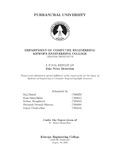Please use this identifier to cite or link to this item:
https://elibrary.khec.edu.np:8080/handle/123456789/872| Title: | Fake News Detection |
| Authors: | Raj Duwal; Ram Simachhwa; Rohan Shingkhwal; Shivansh Duwadi Sharma; Sujeet Chakradhar |
| Advisor: | Er. Reena Manandhar |
| Keywords: | SVM;LR LSTM BERT AI UI CNN Supervised Learning Machine |
| Issue Date: | 2024 |
| College Name: | Khwopa Engineering College |
| Level: | Bachelor's Degree |
| Degree: | BE Computer |
| Department Name: | Department of Computer Engineering |
| Abstract: | This study explores the application of machine learning algorithms to identify fake news using a dataset sourced from Kaggle. The dataset comprises a balanced collection of legitimate and fabricated news articles, providing a robust foundation for training and evaluating models. We employed a range of text preprocessing techniques, including tokenization and vectorization ( Word2Vec, TF-IDF), to transform the raw text data into suitable input features. Various supervised learning algorithms, such as Logistic Regression, Support Vector Machines (SVM), Long Short Term Memory (LSTM) and Bidirectional Encoder Representations from Transformers (BERT), were implemented and compared based on their accuracy, precision, recall, and F1-score. To enhance the accuracy and reliability of the detection system, we scrape news articles from Google News, comparing the similarity between user-submitted content and authentic news sources. By calculating a similarity score, we effectively determine the likelihood of the input news being fake. Our approach demonstrates improved detection accuracy by incorporating real-time data, making it robust against novel and evolving fake news content. Our results demonstrate that LSTM achieved the highest performance, with an F1-score of 1.0, indicating its efficacy in distinguishing between real and fake news. After LSTM, SVM has 2nd highest f1-score of 0.99. The third most effective model was Logistic Regression with f1-score of 0.98 and finally BERT with f1-score of 0.94. This study underscores the potential of machine learning in combatting misinformation and highlights the importance of continued research in this area to enhance the robustness and reliability of fake news detection systems. |
| URI: | https://elibrary.khec.edu.np:8080/handle/123456789/872 |
| Appears in Collections: | PU Computer Report |
Files in This Item:
| File | Description | Size | Format | |
|---|---|---|---|---|
| fake news.pdf Restricted Access | 3.58 MB | Adobe PDF |  View/Open Request a copy |
Items in DSpace are protected by copyright, with all rights reserved, unless otherwise indicated.
